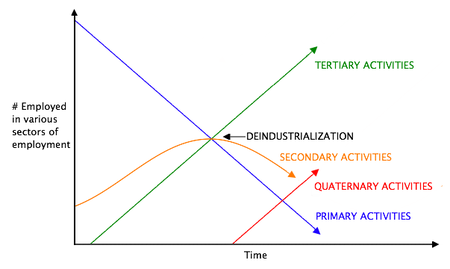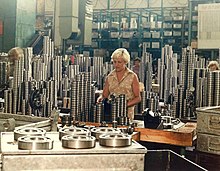Industry (economics)

In macroeconomics, an industry is a sector that produces goods or related services within an economy.[1] The major source of revenue of a group or company is an indicator of what industry it should be classified in.[2] When a large corporate group has multiple sources of revenue generation, it is considered to be working in different industries.
Manufacturing
The mechanized assembly line was introduced to assemble parts in a repeatable fashion, with individual workers performing specific steps during the process. This led to significant increases in efficiency, lowering the cost of the end process. Later, automation was introduced to incrementally replace human operators, a trend that has accelerated with the development of the computer and the robot.
Industrial development

Prior to the Industrial Revolution in Europe and North America, followed by further industrialization throughout the world in the 20th century, most economies were largely agrarian. Basics were often made within the household and most other manufacturing was carried out in smaller workshops by artisans with limited specialization or machinery.[3]
In Europe during the late Middle Ages, artisans in many towns formed guilds to self-regulate their trades and collectively pursue their business interests. Economic historian Sheilagh Ogilvie has suggested the guilds further restrained the quality and productivity of manufacturing.[4] There is some evidence, however, that even in ancient times, large economies such as the Roman empire or Chinese Han dynasty had developed factories for more centralized production in certain industries.[citation needed]
With the Industrial Revolution, the manufacturing sector became a major part of European and North American economies, both in terms of labor and production, contributing possibly a third of all economic activity. Along with rapid advances in technology, such as steam power and mass steel production, the new manufacturing drastically reconfigured previously mercantile and feudal economies. Even today, industrial manufacturing is significant to many developed and semi-developed economies.
Deindustrialisation

Historically certain manufacturing industries have gone into a decline due to various economic factors, including the development of replacement technology or the loss of competitive advantage. An example of the former is the decline in carriage manufacturing when the automobile was mass-produced.
A recent trend has been the migration of prosperous, industrialized nations towards a post-industrial society. This has come with a major shift in labor and production away from manufacturing and towards the service sector, a process dubbed tertiarization.[5][6] Additionally, since the late 20th century, rapid changes in communication and information technology (sometimes called an information revolution) have allowed sections of some economies to specialize in a quaternary sector of knowledge and information-based services. For these and other reasons, in a post-industrial society, manufacturers can and often do relocate their industrial operations to lower-cost regions in a process known as off-shoring.
Measurements of manufacturing industries outputs and economic effect are not historically stable. Traditionally, success has been measured in the number of jobs created. The reduced number of employees in the manufacturing sector has been assumed to result from a decline in the competitiveness of the sector, or the introduction of the lean manufacturing process.
Related to this change is the upgrading of the quality of the product being manufactured. While it is possible to produce a low-technology product with low-skill labour, the ability to manufacture high-technology products well is dependent on a highly skilled staff.
Industrial policy
Today, as industry is an important part of most societies and nations, many governments will have at least some role in planning and regulating industry. This can include issues such as industrial pollution, financing, vocational education, and labour law.
Industrial labour

In an industrial society, industry employs a major part of the population. This occurs typically in the manufacturing sector. A labour union is an organization of workers who have banded together to achieve common goals in key areas such as wages, hours, and other working conditions. The trade union, through its leadership, bargains with the employer on behalf of union members (rank and file members) and negotiates labour contracts with employers. This movement first rose among industrial workers.
Effects on slavery
Rome and other ancient Mediterranean cultures in particular relied on slavery throughout their economy. While serfdom largely supplanted the practice in Europe during the Middle Ages, several European powers reintroduced slavery extensively in the early modern period, particularly for the harshest labor in their colonies. The Industrial revoltion played a central role in the later abolition of slavery, partly because domestic manufacturing's new economic dominance undercut interests in the slave trade.[7] Additionally, the new industrial methods required a complex division of labor with less worker supervision, which may have been incompatible with forced labor.[8]
War

The Industrial Revolution changed warfare, with mass-produced weaponry and supplies, machine-powered transportation, mobilization, the total war concept and weapons of mass destruction. Early instances of industrial warfare were the Crimean War and the American Civil War, but its full potential showed during the world wars. See also military-industrial complex, arms industries, military industry and modern warfare.
See also
References
- ^ Industry | Define Industry at Dictionary.com Archived 2014-02-04 at the Wayback Machine
- ^ "'Definition of Industry' Investopedia". 2003-11-20. Archived from the original on 2017-07-22.
- ^ "Industrial Revolution - Facts & Summary - HISTORY.com". HISTORY.com. Retrieved 2018-07-04.
Before the advent of the Industrial Revolution, [...] [m]ost manufacturing was done in homes or small, rural shops, using hand tools or simple machines.
- ^ Ogilvie, Sheilagh (May 2004). "Guilds, efficiency, and social capital: evidence from German proto-industry" (PDF). Economic History Review. 57 (2): 286–333. doi:10.1111/j.1468-0289.2004.00279.x. hdl:10419/76314.
The empirical findings cast doubt on views that guilds existed because they were efficient institutional solutions to market failures relating to product quality, training, and innovation.
- ^
Betzelt, Sigrid (2001). The Third Sector as a Job Machine?: Conditions, Potentials, and Policies for Job Creation in German Nonprofit Organizations. European University Studies: Economics and Management - ISSN 0531-7339. Vol. 2805. Peter Lang. p. 52. ISBN 9780820454306. Retrieved 6 November 2019.
'Tertiarization', the quantitative shift of economic relevance from agricultural and especially industrial production [...].
- ^
Pujolar, Joan (2018). "Post-Nationalism and Language Commodification". In Tollefson, James W.; Pérez-Milans, Miguel (eds.). The Oxford Handbook of Language Policy and Planning. New York: Oxford University Press. p. 487. ISBN 9780190458898. Retrieved 6 November 2019.
Tertiarization refers to the dominance of so-called third- or tertiary-sector production in the economy.
- ^
Harley, Charles (September 2011). "Slavery, the British Atlantic Economy and the Industrial Revolution" (PDF). Working Paper: 7–8.
As the Industrial Revolution proceeded, the main focus of economic attention shifted to the new industries created by Britain's technological prominence. These industries looked not for protection but for an opening of export markets. As the political economy shifted, the West Indian interest became vulnerable to their opponents. The slave trade was abolished in 1807 and slavery eventually abolished in 1833.
- ^ Lagerlöf, Nils-Petter (2006-08-30). "Slavery and other property rights" (PDF).
Some argue that slavery died out due to the rise of industrial production modes, involving a larger number of work tasks, thus making slavery more costly in terms of supervision.
{{cite journal}}: Cite journal requires|journal=(help)
Bibliography
- Krahn, Harvey J., and Graham S. Lowe. Work, Industry, and Canadian Society. Second ed. Scarborough, Ont.: Nelson Canada, 1993. xii, 430 pp. ISBN 0-17-603540-0
External links
 Media related to Industries at Wikimedia Commons
Media related to Industries at Wikimedia Commons Quotations related to industry at Wikiquote
Quotations related to industry at Wikiquote- Industry (economics) at the Encyclopædia Britannica
